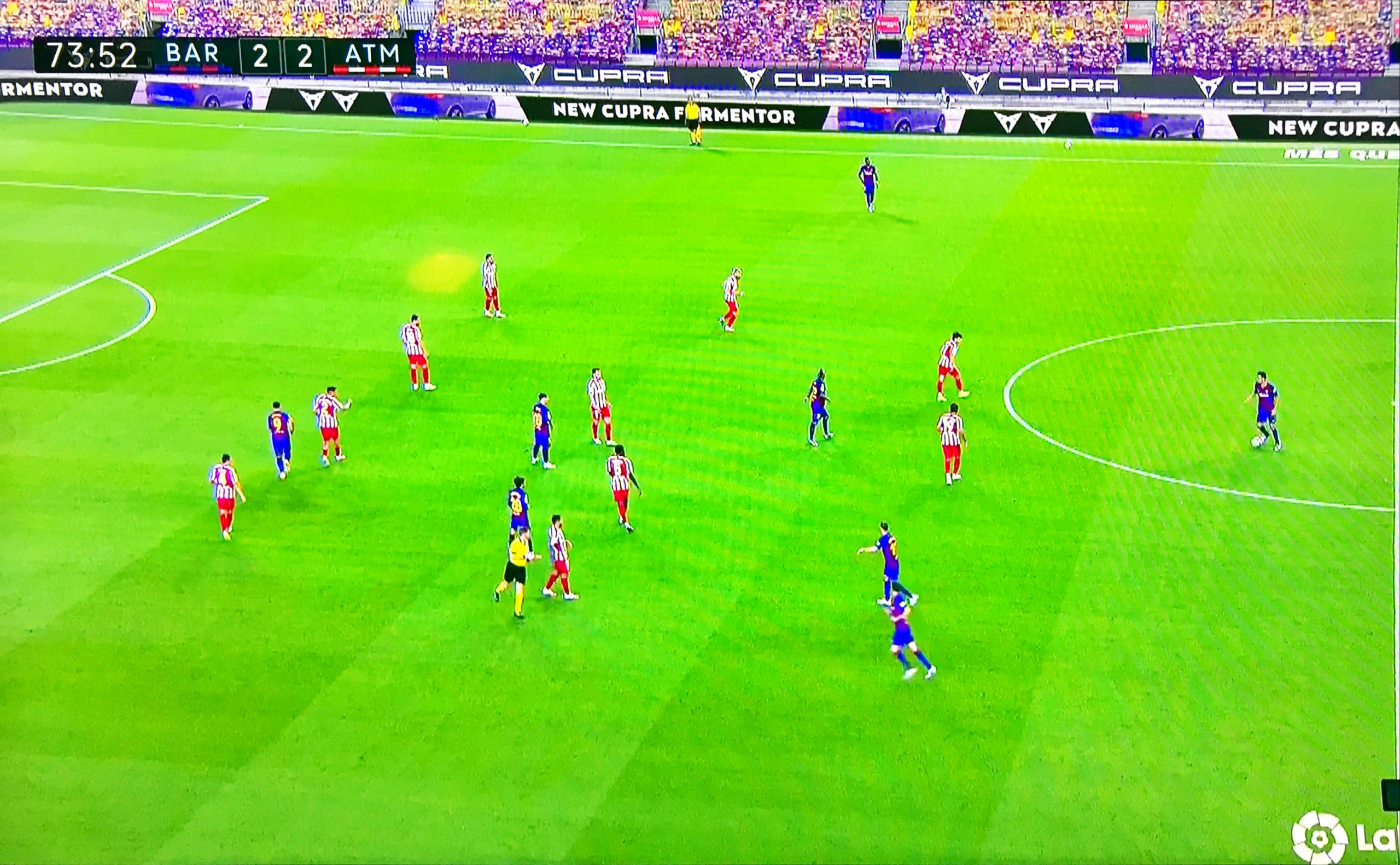If you saw last week’s La Liga game between FC Barcelona and Atlético de Madrid you’ll have seen Diego Simeone’s side give the perfect demonstration of how to play a compact 4-4-2 formation out of possession in order to deny Barça space.
As the above image shows, with around 75 minutes on the clock, the scores tied at 2-2, Barça desperate for a win to keep their league title hopes alive and Atlético more than happy to hang on for a draw, Simeone’s team organised themselves into a classic flat 4-4-2 formation: two banks of four in defence and midfield and a flat two up front.
The most notable thing about that shape was how compact they made it. You can see the rolled stripes on the grass: they’ve been made with a roller 6-yards wide (the third stripe ends perfectly in line with the edge of the 18-yard box): the defence are lined up at the start of the 6th stripe; the midfielders are all in the 7th stripe and the two forwards are midway through the 8th stripe.
And it’s about the same distance from the right-sided players to the left-sided players as it is from the defenders to the forwards.
In other words, the entire outfield team is occupying an area roughly 15 yards square.
Why stay so compact?
Any analysis of Atlético’s approach needs to start with asking why they chose to stay so compact.
The FA’s defending principles of play as defined in the England DNA suggest that achieving a compact shape will reduce attacking opportunities.
You can see that happening in the image: Leo Messi and Riqui Puig, the second- and third-left Barça players, are trying to find space in between the lines of the Atlético defence and midfield, but it just isn’t there. Luis Suarez, Barça’s 9, is trying to pull the centre-backs away to create the space, but it looks as though they’re holding their line and he will just run offside if the player on the ball (Sergio Busquets) tries to play it to him.
Madrid’s forwards, Marcos Llorente and Diego Costa, are also defending a line and staying no more than a goal’s width apart, making the pass through to Arturo Vidal difficult.
Busquets choices are to go to the two players on the left, where there is potentially an overlap if they can isolate the right-midfielder, or wide right, where Barça’s right-back Nélson Semedo has pushed up and has space galore – but is fantastically isolated.
Madrid will happily let the ball go out into those wide areas, knowing that they can shuffle their 15-yard square phalanx around the pitch, denying Barcelona’s most creative players the space they need to do them damage.
How do they achieve it?
The more difficult question for me is how Simeone can coach his players to maintain such an organised, compact shape deep into the game with the match balanced on a knife-edge.
The concentration and calmness needed to leave Semedo in all that space; to monitor but not move towards the overlap developing on the left; to not press Busquets so deep in your own half, cannot be easy.
And to organise yourselves in this way needs time. Even against a team who like to build attacks patiently, like Barcelona, transitioning into such an organised shape can’t happen instantly.
One tactic that footballers and coaches use is to employ the Number 9 to shadow-press while the ball is in front of his team – closing down opposition players in possession without actually tackling them, allowing them to keep the ball but denying them the time and space to do anything dangerous with it – while the ball is in front of his team. That enables his teammates to drop back and organise themselves into the required defensive shape.
Leicester City have used Jamie Vardy successfully in this way for several years, including in their Premier League-winning season.
Atlético’s forwards do this to a certain extent, but largely as we can see from the photo they have positions of their own to take up within the 4-4-2 shape – so Costa can’t over-commit to closing down Busquets in this example.
So how do they do this – and how do they do it so quickly?
Discipline is the simplest answer – but not a complete one. After all, this is not the discipline of players following their manager’s instructions: Simeone can’t bark instructions at all ten of them at once.
What Atlético’s demonstration shows us is their ability to self-organise, as individuals within a team, based on constant analysis of and reaction to the match situation as it evolves.
That comes through time working in these formations on the training ground, undoubtedly. It comes from preparation and advance knowledge of your opponents, without question. And it goes without saying that it comes from immense work on physical fitness.
But it surely also comes from development of psychological skills such as the ability to stay calm, react and make decisions under pressure. And that, as much as anything, is what I took away from seeing this situation in this football match.
